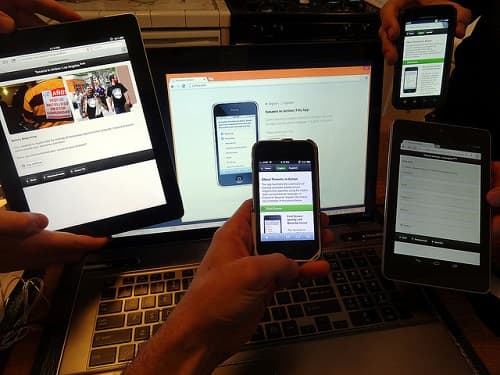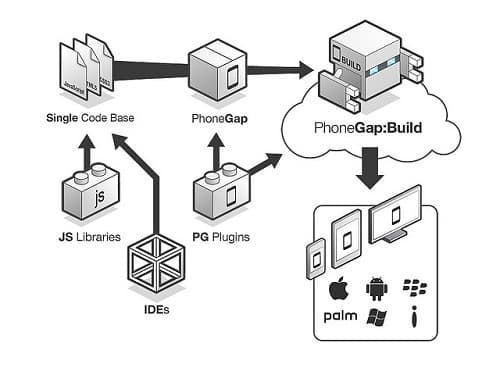Hybrid App Development in the year 2017
The concept of hybrid app development is getting perfected and polished, and their relevance getting the upper hand, when compared to native app development. What makes native app development different from hybrid app development is that you don’t have to create separate codes when you are working on different devices; just one code would be enough for different devices. Native app development involves using native programming apps; for example the native programming language for Android is Java and for iPhone it is Objective C and Swift. To create hybrid apps, the following web technologies were used, though they were not perfect – HTML5, CSS and JavaScript. Apps created using hybrid technologies can be opened on both ITunes app store and Google Play store while native apps allow you to open them only through their respective stores.
Hybrid app development now has the capacity to bring the “native look and feel” as evidenced by
- Gmail
- Uber
- Evernote and
- Amazon Appstore
Many companies have mobile apps on their agenda and they are going to adapt to the latest technology in mobile app development. Hybrid HTML5 application development will be adapted by most of them and will be the most obvious choice for several others.
Here are some basic reasons why hybrid app development is gaining momentum and will continue to rule the app development world for several more years
Customers are demanding top quality apps
The expectation level of customers demanding high-level apps is growing by the day. Hybrid apps written in Javascript, CSS and HTML are being wrapped by Cordova framework. This would then be downloadable to users. And the development of high quality apps has given rise to demand for apps that can be downloaded in various platforms. Developers are also embracing this technology because they do not have to keep changing the codes for various apps. One code, one app – downloaded in multiple apps. This is possible only through hybrid apps.
Seamless experience
Though customers have started using smartphones almost all the time they are online, the good old desktop is still in existence. People want a continuous usage between tablets, mobile phones and computers. This is possible only through hybrid applications. So the future is in hybrid applications.
Cost factor – Through the “one-app-multiple-platform” concept, companies can save a lot of money as well. Because, only one app needs to be created and that would be sufficient for other platforms.
Performance improvement
It is true that when hybrid apps were first introduced, they were not perfect and required improvement. The fact that mobile devices now have excellent web rendering engines coupled with the efficacy to run huge amounts of Javascript in the shortest time have led to several positive changed in hybrid app development.
Hybrid apps are hugely popular among developers because they no longer have to be locked in within the constraints of proprietary platforms. Businesses also like to hire developers who work on hybrid apps because they don’t have to hire different developers for making different apps.
Companies are currently investing in the creation and development of hybrid apps. Frameworks like Ionic, Cordova and Anguar help in developing hybrid mobile apps. When you are getting ready to make a hybrid app you can use Cordova proper or use Phone Gap Cordova by entering into Adobe’s ecosystem. Though it was Nitobi that created PhoneGap, Adobe purchased it from them in 2011. Through Cordova, you can use simple and yet powerful API to make use of Javascript functions and transfer any kind of data from native to web applications. The potential of Cordova is still being explored and you can pretty much to do the same applications that you can do with any native plugin.
Apps that are created in this manner are available for download through the App Store. They can be downloaded any number of times. If you are thinking of becoming a provider for mobile applications then the best thing would be to develop hybrid apps. Only then will you be able to keep the interests of the end-user in mind.
Sencha Touch is another extremely popular MVC based Javascript framework that would help you create cross-platform applications. Developers love Sencha Touch because it helps them go though high performance user interface components that can be used on mobile devices. Sencha Touch helps you create apps that works on Android, iOS, Windows Phone, Black Berry and so on. Additionally, there is a very advanced charting package that would help developers visualize data on various mobile devices.
The Bottom Line
When you are thinking of any particular framework to create the hybrid app consider whether it will be useful for all your future requirements as well. Sometimes you may feel the need to switch to a different framework and if that happens, then you will have to start the tedious process of reprogramming. You have varying customers on various mobile devices and the market is different for Android, iOS and Windows Phone. It might vary from country to country as well. What is popular in India may not be so in Germany. Because of this disparity, you will have to rely on hybrid apps. It is imperative that you must build hybrid apps because only then will you get access to the app store and that’s where a chunk of your target audience lie. And you can leverage the capabilities of hybrid app to its full potential when new versions of mobile applications are released.
Interesting links about the topic:
What’s the future: hybrid or native apps?
What is Hybrid Mobile App?
Advantages of Hybrid Apps
Pictures: Flickr.com/PROCraig Dietrich | PROSam Churchill

The author: Reema Oamkumar is engaged as a thought leader at www.Software-Developer-India.com which is a part of the YUHIRO Group. YUHIRO is a German-Indian enterprise which provides programmers to IT companies, agencies and IT departments.



nice